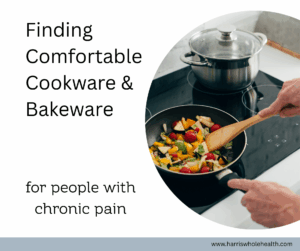June is disability pride month—it’s chronic illness month, too. One of the topics that tends to come up with patients is making the kitchen accessible. Cookware is a big part of that, so let’s explore options. Changing things up can make a big difference. A skillet might weigh a pound or so empty, and some Dutch ovens can weigh 18+ pounds empty, which can leave people feeling achy and exhausted before the cooking part starts. So let’s review the pros and cons of commonly available options.
Cookware

Aluminum is one of the lightest options out there; however, there’s some risk of it leaching into food. It needs to be specially treated—aka anodized aluminum—and, ideally, food isn’t stored in aluminum. Unfortunately aluminum isn’t compatible with induction stoves.
Stainless steel is another option that tends to be on the lighter side. The weight will depend on the size, the # of layers, and whether or not it has a lid. Many, but not all, are compatible with induction stoves. It’s a bit tricky, because the higher end options (All clad, etc.) tend to advertise as heavy=good, because heavier cookware leads to more even heat distribution and nicer browning, and the 5 ply (D5 series) is heavier than the D3.
Copper makes for excellent cookware, but again, it’s generally heavier. Same with cast iron cookware, which unfortunately tends to be quite a lift.
Non-stick
As a general rule, I don’t love Teflon; I know many people like the convenience of non-stick. Options like carbon steel and ceramics or carbon can be great choices. Misen is carbon and has pans under 2 pounds. Ceramic options, such as GreenPan are also non-stick and non-reactive and tend to be on the lighter side—starting under 2 pounds, and increasing with bigger pots. But, sadly, the gorgeous LeCreuset Dutch ovens are definitely not great joint-friendly options.
Generally, most frying pans are going to have one handle, as opposed to sauté pans, which have two—and two handles can make it easier to distribute weight and reduce wrist strain. French skillets are the exception and generally have two handles.
Also, larger pans are always going to be heavier.
Bakeware:
Glass, ceramics, metal, oh my!
Again, a range of options for baking. A 9×13 glass dish weighs just under 6 pounds. A ceramic dish of the same size is about 4-5 lbs (without a lid). A metal pan of that size is closer to 1-2 pounds; if a cooking sheet is workable for the job, it weighs slightly less.
Of course, if you’re going thrifting, you can get a feel of the weights and how they might work for you–but remember, it’s always going to be heavier with food.
Hopefully, this gives some ideas of swaps that might lighten the load, literally and figuratively.
